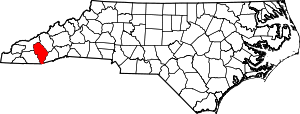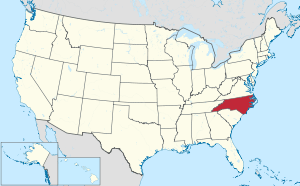Jackson County, North Carolina
Jackson County is a county located in the southwest of the U.S. state of North Carolina. As of the 2010 census, the population was 40,271.[1] Since 1913 its county seat has been Sylva,[2] replacing Webster.
Jackson County | |
|---|---|
 The Old Jackson County Courthouse in Downtown Sylva | |
 Seal | |
 Location within the U.S. state of North Carolina | |
 North Carolina's location within the U.S. | |
| Coordinates: 35°17′N 83°08′W | |
| Country | |
| State | |
| Founded | 1851 |
| Named for | Andrew Jackson |
| Seat | Sylva |
| Largest town | Cullowhee |
| Area | |
| • Total | 495 sq mi (1,280 km2) |
| • Land | 491 sq mi (1,270 km2) |
| • Water | 3.8 sq mi (10 km2) 0.8%% |
| Population | |
| • Estimate (2018) | 43,327 |
| • Density | 82/sq mi (32/km2) |
| Time zone | UTC−5 (Eastern) |
| • Summer (DST) | UTC−4 (EDT) |
| Congressional district | 11th |
| Website | www |
Jackson County comprises the Cullowhee, NC Micropolitan Statistical Area.
History
This area was part of Cherokee Nation territory at the time of European encounter. The trust land known as Qualla Boundary extends into part of Jackson County and is the base for the federally recognized tribe of the Eastern Band of Cherokee Indians. They contribute to the high proportion of Native Americans among the county population — more than ten percent.
The county was organized in 1851 from parts of Haywood and Macon counties. It was named for Andrew Jackson, President of the United States from 1829 to 1837.[3] The original county courts were held at the Dan Bryson home in the community of Beta in Scott Creek township, and moved to Webster the following year.
In 1861 parts of Jackson and Henderson counties were combined to form Transylvania County. In 1871 parts of Jackson and Macon counties were combined to form Swain County. In 1913 Sylva became the county seat.
Geography
According to the U.S. Census Bureau, the county has a total area of 495 square miles (1,280 km2), of which 491 square miles (1,270 km2) is land and 3.8 square miles (9.8 km2) (0.8%) is water.[4] The Tuckasegee River flows through the county.
Government and public safety
Government
Jackson County as mandated by the laws of North Carolina is governed by an elected 5 member four year term Board of Commissioners who appoint and oversee the actions of the County Manager.[5]
Adjacent counties
- Haywood County - northeast
- Transylvania County - east
- Oconee County, South Carolina - south
- Macon County - west
- Swain County - northwest
National protected areas
- Blue Ridge Parkway (part)
- Nantahala National Forest (part)
- Judaculla Rock (part)
- Cherokee Indian Reservation, Eastern Band of Cherokees (part)
Demographics
| Historical population | |||
|---|---|---|---|
| Census | Pop. | %± | |
| 1860 | 5,515 | — | |
| 1870 | 6,683 | 21.2% | |
| 1880 | 7,343 | 9.9% | |
| 1890 | 9,512 | 29.5% | |
| 1900 | 11,853 | 24.6% | |
| 1910 | 12,998 | 9.7% | |
| 1920 | 13,396 | 3.1% | |
| 1930 | 17,519 | 30.8% | |
| 1940 | 19,366 | 10.5% | |
| 1950 | 19,261 | −0.5% | |
| 1960 | 17,780 | −7.7% | |
| 1970 | 21,593 | 21.4% | |
| 1980 | 25,811 | 19.5% | |
| 1990 | 26,846 | 4.0% | |
| 2000 | 33,121 | 23.4% | |
| 2010 | 40,271 | 21.6% | |
| Est. 2018 | 43,327 | [8] | 7.6% |
| U.S. Decennial Census[9] 1790-1960[10] 1900-1990[11] 1990-2000[12] 2010-2013[1] | |||
As of the census[13] of 2010, there were 40,271 people. As of the 2000 Census, there were 13,191 households and 8,587 families residing in the county. The population density was 68 people per square mile (26/km²). There were 19,291 housing units at an average density of 39 per square mile (15/km²). The racial makeup of the county was 85.68% White, 1.67% Black or African American, 10.20% Native American (mostly Cherokee people), 0.51% Asian, 0.02% Pacific Islander, 0.55% from other races, and 1.38% from two or more races. 1.74% of the population were Hispanic or Latino of any race. 18.5% were of American, 13.7% English, 11.3% Irish, 10.5% German and 9.2% Scots-Irish ancestry according to Census 2000. 95.3% spoke English, 2.1% Spanish and 1.5% Cherokee as their first language.
There were 13,191 households out of which 25.50% had children under the age of 18 living with them, 51.40% were married couples living together, 10.00% had a female householder with no husband present, and 34.90% were non-families. 27.00% of all households were made up of individuals and 9.80% had someone living alone who was 65 years of age or older. The average household size was 2.30 and the average family size was 2.79.
In the county, the population was spread out with 19.00% under the age of 18, 17.90% from 18 to 24, 24.40% from 25 to 44, 25.00% from 45 to 64, and 13.80% who were 65 years of age or older. The median age was 36 years. For every 100 females there were 95.40 males. For every 100 females age 18 and over, there were 93.10 males.
The median income for a household in the county was $32,552, and the median income for a family was $40,876. Males had a median income of $27,738 versus $22,029 for females. The per capita income for the county was $17,582. About 9.50% of families and 15.10% of the population were below the poverty line, including 15.70% of those under age 18 and 15.20% of those age 65 or over.
Communities
Village
Townships
The county is divided into fifteen townships:
Barker's Creek: Named for the creek which originates and flows through the township before entering the Tuckasegee River. It includes the Dicks Creek, Barkers Creek, and Wilmont communities, and US 74/23 runs as a four-lane divided highway through the township. It is served by Smokey Mountain Elementary School and Smoky Mountain High School. Formerly, the Log Cabin Association Consolidated School served the township, but it closed when Smokey Mountain Elementary opened in 1980.
Canada: Named for the tall ridges, narrow valleys, and sharp peaks of this part of the county, the main waterway is the East Fork of the Tuckasegee River which flows into the River Township before joining the West Fork, becoming the Tuckasegee River. There are four major lakes, Bear, Wolf, Tanasee Creek, and Ceader Cliff, in the township. It is served by NC 281 and is one of the most remote locations in the county. It is served by Cullowhee Valley School and Smoky Mountain High School. Before the 1990s, the schools for the area were Canada Consolidated School and Cullowhee High School, both closed in the 1980s.
Caney Fork: Named for the creek that flows through the township, Caney Fork, which empties into the Tuckasegee River at East LaPorte. The main road is Caney Fork Road, and the area is served by Cullowhee Valley School and Smoky Mountain High School. Prior to 1964 the schools that served the area were Johns Creek Elementary and Cullowhee High School.
Cashiers: Named for a lost horse, the town of Cashiers is located here, as well as the communities of Panthertown Valley, Whiteside Cove, Fairfield, and Sapphire. It is served by NC 107 and US 64. The Eastern Continental Divide follows a ridge north of the township, and defines the boundaries between the Cashiers, Canada, and Glenville townships. The Chattooga, Horsepasture, and Toxaway rivers all originate or flow through the township. It is served by Blue Ridge School, which consolidated Glenville School and Cashiers Elementary in 1975.
Cullowhee: The Cherokee name for the valley was corrupted from its original name into Cullowhee, the original meaning either "Valley of the Lilies" or "Valley of the Buzzards." The valley of the lilies nickname is more commonly referred to. NC 107, Old NC 107, and NC 107-Alternate all serve the township as major roads, though NC 107 is the only 4-lane roadway. Western Carolina University, the village of Forest Hills, and the communities of Speedwell, Old Cullowhee Road, Buzzards Roost, and Dicks Gap are all within the township. It was one of the first areas in the county to be settled by the whites, along with Caney Fork, River, Scott Creek, and Canada townships. It is the largest township population-wise according to the 2000 United States Census. The Tuckasegee River and Cullowhee Creek both flow through the township, with the latter emptying into the former around Old Cullowhee Road. It is served by Cullowhee Valley School, located in the township, and Smoky Mountain High School in Sylva. Formerly, there was Cullowhee High School, but it closed in 1988.
Dillsboro: Named after the Dills Family who founded the town, the township is home to the town of Dillsboro. To the northwest of Dillsboro, Scotts Creek, which flows from Scott Creek Township through Sylva Township into Dillsboro Township, empties into the Tuckasegee River. US 74/23, US 441, and NC 107 all converge in two major intersections within the township. The township is served by Smokey Mountain and Fairview elementary schools and by Smoky Mountain High School. It hasn't had its own school since Dillsboro Elementary closed in 1951. The students were then transferred to Log Cabin School in Barkers Creek Township or Sylva Elementary School in Sylva township.
Greens Creek: Named for the creek which flows through most of the township before emptying into Savannah Creek, Greens Creek Township is served by US 441, in the form of a four-lane highway along the western edge. Greens Creek Road goes through the middle of the township. It is served by Fairview Elementary School and Smoky Mountain High School. It was formerly served by the Savannah Consolidated School, which opened in 1940 and closed in 1973.
Hamburg: Named for the fort and original name of Glenville, the township is served by NC 107. The area was once a large valley, but the valley was flooded in 1941 to form Lake Glenville. The West Fork of the Tuckasegee River originates within the township, and flows north into the River Township. Blue Ridge School is located in the township and serves the township. It originated from the consolidation of the Glenville School and Cashiers Elementary School in 1975.
Mountain: Named for Cullowhee Mountain which it resides on, the Mountain Township is served by NC 107 Alternate. The headwaters of Cullowhee Creek are located here, flowing north into Cullowhee Township before joining the Tuckasegee River. It is served by Cullowhee Valley School/Smoky Mountain High School, and was formerly served by Cullowhee High School and Camp Lab Elementary.
Qualla: Named for the Qualla Boundary which takes up a lion's share portion of the township, Qualla Township is served by US 441, US 19, and US 74/23. Smokey Mountain Elementary School is located in the township, resulting from the 1980 consolidation of Qualla Elementary School and Log Cabin Association Consolidated School. It is served by the Jackson County Public School System and the Cherokee Reservation School System. Students can choose to either go to Smokey Mountain Elementary/Smoky Mountain High School, Cherokee School, or Swain East Elementary, Swain Middle School and Swain High School. The communities of Qualla, Birdtown, Soco, Whittier, Indian Hills, and Wilmont are all located at least partially, if not wholly, within the township.
River: Named for the Tuckasegee River, which converges from two streams into one within the township, it is served by NC 107 and NC 281. The community of Tuckasegee is located in the township. It is served by Cullowhee Valley School/Smoky Mountain High School, and, prior to 1958, Tuckasegee School and Cullowhee High School.
Savannah: Named for Savannah Creek, which runs through the district, Savannah Township is home to the Viewpoint, Pumpkintown, Savannah, and Fort Wilderness communities. The township is served by four-lane US 441. Fairview Elementary School and Smoky Mountain High School serve the township as well. It was home to Savannah Consolidated School, which fed into Webster High School and later Sylva-Webster High School, from 1940 until 1973.
Scotts Creek: Named for Scotts Creek, which begins and flows through the township before running into Sylva Township. It is served by US 74/23 and old US 19/23, which run through the five communities within the township, Balsam, Willets, Ochre Hill, Addie and Beta. The Murphy Branch Railroad also runs through the township. Scotts Creek School has served the township since 1951, and had a new building constructed in 2001. The old school building became the Jackson County School of Alternatives (the HUB).
Sylva: Named for William D. Sylva, as is the town of Sylva, located within the township, which is served by NC 107, US 74/23, and BUS 23. The Jackson County Courthouse and Library are both located in the township. Scotts Creek runs through the township before emptying into Dillsboro Township. The township is served by Fairview and Scotts Creek elementary schools and Smoky Mountain High School. Formerly, students in the township would have gone to Sylva Elementary/Sylva High School, and later Sylva-Webster High School, but consolidation has closed many smaller schools in the county.
Webster: The location of the town of Webster, Webster Township sits at the original geographical center of the county, which has moved to Cullowhee Township due to land taken away for the formation of Swain and Transylvania counties. It was for many years home to the only town in Jackson County. It is served by NC 116 and NC 107. The county seat designation and courthouse were located here from 1851 to 1913, but the county seat subsequently moved to Sylva. The township once was home to Webster Elementary School (1936–1973) and Webster High School (1936–1960), but now the schools that serve the township are Fairview Elementary School (1973) and Smoky Mountain High School (1960/1988).
Law and government
Jackson County is a member of the regional Southwestern Commission council of governments.
Jackson County contains a portion of the Qualla Boundary, a land trust of historic territory of the federally recognized Eastern Band of Cherokee Indians. The tribe is sovereign in its territory. The reservation operates Harrah Casino, which is open to the public, as are associated resort facilities there.
Politics
Jackson is alongside Buncombe and Watauga one of three "swing" counties in Western North Carolina. Except for 1980, it voted with the winner in every Presidential election from 1960 to 2008; however, the intense dislike of Obama in Appalachia meant that Mitt Romney was able to carry the county whilst losing the Presidential election.
| Year | Republican | Democratic | Third parties |
|---|---|---|---|
| 2016 | 52.7% 9,870 | 41.2% 7,713 | 6.0% 1,130 |
| 2012 | 49.4% 8,254 | 48.5% 8,095 | 2.1% 352 |
| 2008 | 46.6% 7,854 | 52.0% 8,766 | 1.5% 246 |
| 2004 | 51.9% 7,351 | 47.5% 6,737 | 0.6% 86 |
| 2000 | 51.5% 6,237 | 47.2% 5,722 | 1.3% 162 |
| 1996 | 40.4% 4,244 | 49.6% 5,211 | 10.0% 1,051 |
| 1992 | 37.0% 4,275 | 49.8% 5,753 | 13.2% 1,530 |
| 1988 | 51.0% 5,166 | 48.7% 4,933 | 0.2% 24 |
| 1984 | 56.0% 5,582 | 43.8% 4,367 | 0.3% 25 |
| 1980 | 44.5% 4,140 | 52.2% 4,857 | 3.4% 313 |
| 1976 | 40.3% 3,536 | 59.5% 5,223 | 0.3% 26 |
| 1972 | 59.1% 4,709 | 39.8% 3,169 | 1.1% 89 |
| 1968 | 48.1% 3,747 | 38.0% 2,956 | 13.9% 1,080 |
| 1964 | 39.4% 3,183 | 60.7% 4,905 | |
| 1960 | 50.7% 4,017 | 49.3% 3,900 | |
| 1956 | 48.1% 3,503 | 52.0% 3,787 | |
| 1952 | 46.1% 3,680 | 53.9% 4,296 | |
| 1948 | 37.5% 2,520 | 59.6% 4,005 | 3.0% 200 |
| 1944 | 39.6% 2,694 | 60.4% 4,109 | |
| 1940 | 34.6% 2,410 | 65.4% 4,563 | |
| 1936 | 40.1% 3,061 | 59.9% 4,580 | |
| 1932 | 39.0% 2,813 | 60.5% 4,360 | 0.5% 35 |
| 1928 | 52.6% 3,512 | 47.5% 3,171 | |
| 1924 | 47.2% 2,788 | 52.5% 3,100 | 0.3% 17 |
| 1920 | 49.7% 2,355 | 50.3% 2,385 | |
| 1916 | 49.7% 1,288 | 50.4% 1,306 | |
| 1912 | 13.9% 315 | 53.6% 1,210 | 32.5% 734 |
2016 presidential primaries
In the 2016 Republican Primary in Jackson County, Donald Trump received 1,624 votes (or 39.5% of the total votes) followed by Ted Cruz who came in second with 1,434 votes (or 34.9% of the total votes). In the 2016 Democratic Primary, Bernie Sanders received 3,021 votes (57.0% of the total) whereas Hillary Clinton only received 2,022 votes (38.1% of the total).[15] In the general election Donald Trump received 9,870 votes (or 52.7% of the total vote); whereas, Hillary Clinton received 7,713 votes (41.2% of the total vote) and Libertarian Candidate Gary Johnson received 742 votes (4.0% of total votes in the county).[16] In this regard, Jackson County has the distinction of being one of many counties in the state of North Carolina which Donald Trump won in both the primary election and the general election, and which Hillary Clinton lost in both the primary election and the general election.
Transportation
Airport
The county contains one airport, the Jackson County Airport located one mile (1.6 km) east of Cullowhee. It is governed by the Jackson County Airport Authority.
Railroads
Norfolk Southern Railway operates a portion the Murphy Branch through Jackson County, providing a rail connection with the rest of the country. In Sylva, Norfolk Southern connects with the Great Smoky Mountains Railroad. Interchange between the two lines is handled near Jackson Paper Company. Great Smoky Mountains Railroad operates the rest of the Murphy Branch from Dillsboro to Andrews. Passenger rail service from Sylva to Murphy stopped in 1948, while the freight commercial service lingered on another forty some years before completely stopping in 1983. In 2015, it was reported that Watco, who purchased the section that Norfolk Southern previously owned, was in talks with the town's and counties in an attempt to build a viable tourist railroad clientele. The major obstacle at this point in time is the Cowee Mountain Tunnel which does not meet height and weight specifications for modern rail engines and boxcars.
Roads and highways
Jackson County is served by three main roads: the Great Smoky Mountains Expressway runs east-west across the northern half of the county and connects the county seat of Sylva to Waynesville and Asheville in the east and Cherokee, Andrews and Murphy in the west. North Carolina State Highway 107 connects Sylva and Western Carolina University to Cashiers in the south. U.S. Highway 64 traverses east-west across the southern part of the county connecting Cashiers to Brevard in the east and Highlands in the west.
In popular culture
Several movies have been filmed in the county including the 1993 blockbuster action-adventure The Fugitive starring Harrison Ford and Tommy Lee Jones, the 1972 drama Deliverance, and the 1996 comedy My Fellow Americans starring Jack Lemmon and James Garner.
- The train wreck scene in The Fugitive was filmed in Dillsboro along the Great Smoky Mountains Railroad. The wreckage set can still be viewed on outbound train excursions from Dillsboro. The later scene in a small hospital was filmed at Harris Regional Hospital in Sylva.
- The Great Smoky Mountains Railroad was also used in the filming of My Fellow Americans when they stumble on to a charter train full of North Carolina Tar Heels fans headed for the NCAA Final Four.
- The back side of downtown Sylva was used for a short driving scene in the filming of Deliverance.
- Ron Rash's 2008 novel, "Serena," features Jackson County.
- David Joy's novels, 'Where All Light Tends to Go' and 'The Weight of This World' are set in Jackson County.
- Sylva's Main-street was used in the filming of Three Billboards outside Ebbing, Missouri (2016)
See also
- Blue Ridge Parkway
- Cherokee
- Chattooga River
- Great Smoky Mountains
- Great Smoky Mountains Expressway
- Great Smoky Mountains National Park
- Horsepasture River
- Jackson County Courthouse
- National Register of Historic Places listings in Jackson County, North Carolina
- Qualla Boundary
- Toxaway River
- Tuckasegee River
- Western Carolina University
References
- "State & County QuickFacts". United States Census Bureau. Archived from the original on June 7, 2011. Retrieved October 21, 2013.
- "Find a County". National Association of Counties. Archived from the original on May 31, 2011. Retrieved 2011-06-07.
- Gannett, Henry (1905). The Origin of Certain Place Names in the United States. Govt. Print. Off. pp. 167.
- "2010 Census Gazetteer Files". United States Census Bureau. August 22, 2012. Archived from the original on January 12, 2015. Retrieved January 17, 2015.
- https://www.jacksonnc.org/county-commissioners
- https://www.sheriff.jacksonnc.org/
- sylvapolice.com
- "Population and Housing Unit Estimates". Retrieved July 22, 2019.
- "U.S. Decennial Census". United States Census Bureau. Retrieved January 17, 2015.
- "Historical Census Browser". University of Virginia Library. Retrieved January 17, 2015.
- Forstall, Richard L., ed. (March 27, 1995). "Population of Counties by Decennial Census: 1900 to 1990". United States Census Bureau. Retrieved January 17, 2015.
- "Census 2000 PHC-T-4. Ranking Tables for Counties: 1990 and 2000" (PDF). United States Census Bureau. April 2, 2001. Retrieved January 17, 2015.
- "U.S. Census website". United States Census Bureau. Retrieved 2008-01-31.
- Leip, David. "Dave Leip's Atlas of U.S. Presidential Elections". uselectionatlas.org. Retrieved 2018-03-16.
- "North Carolina Primary Election Results 2016". The New York Times. 2016-09-29. ISSN 0362-4331. Retrieved 2018-03-16.
- "North Carolina Election Results 2016". The New York Times. 2017-08-01. ISSN 0362-4331. Retrieved 2018-03-16.
External links
- Jackson County official website
- North Carolina GenWeb Jackson County - free genealogy resources for the county
- The Sylva Herald
- Jackson County Rescue Squad
- Jackson County Travel & Tourism

